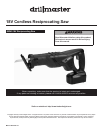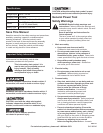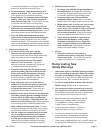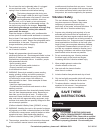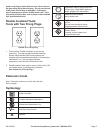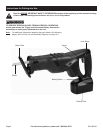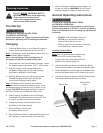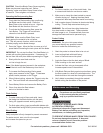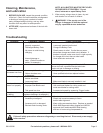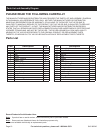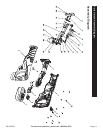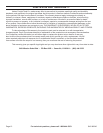Page 3For technical questions, please call 1-800-444-3353.SKU 68240
or a key left attached to a moving part of the
power tool may result in personal injury.
e. Do not overreach. Keep proper footing and
balance at all times. This enables better control
of the power tool in unexpected situations.
f. Dress properly. Do not wear loose clothing or
jewelry. Keep your hair, clothing and gloves
away from moving parts. Loose clothes, jewelry
or long hair can be caught in moving parts.
g. If devices are provided for the connection of
dust extraction and collection facilities, ensure
these are connected and properly used. Use of
these devices can reduce dust-related hazards.
h. Only use safety equipment that has been
approved by an appropriate standards agency.
Unapproved safety equipment may not provide
adequate protection. Eye protection must be ANSI-
approved and breathing protection must be NIOSH-
approved for the specic hazards in the work area.
4. Power tool use and care
a. Do not force the power tool. Use the
correct power tool for your application.
The correct power tool will do the job better and
safer at the rate for which it was designed.
b. Do not use the power tool if the switch
does not turn it on and off. Any power
tool that cannot be controlled with the switch
is dangerous and must be repaired.
c. Disconnect the plug from the power source
and/or the battery pack from the power tool
before making any adjustments, changing
accessories, or storing power tools. Such
preventive safety measures reduce the risk
of starting the power tool accidentally.
d. Store idle power tools out of the reach of
children and do not allow persons unfamiliar
with the power tool or these instructions
to operate the power tool. Power tools are
dangerous in the hands of untrained users.
e. Maintain power tools. Check for misalignment
or binding of moving parts, breakage of parts
and any other condition that may affect the
power tool’s operation. If damaged, have the
power tool repaired before use. Many accidents
are caused by poorly maintained power tools.
f. Keep cutting tools sharp and clean. Properly
maintained cutting tools with sharp cutting edges
are less likely to bind and are easier to control.
g. Use the power tool, accessories and tool bits
etc. in accordance with these instructions,
taking into account the working conditions
and the work to be performed. Use of the
power tool for operations different from those
intended could result in a hazardous situation.
5. Battery tool use and care
a. Recharge only with the charger specied by
the manufacturer. A charger that is suitable
for one type of battery pack may create a risk
of re when used with another battery pack.
b. Use power tools only with specically
designated battery packs. Use of any other
battery packs may create a risk of injury and re.
c. When battery pack is not in use, keep it away
from other metal objects, like paper clips,
coins, keys, nails, screws or other small metal
objects, that can make a connection from
one terminal to another. Shorting the battery
terminals together may cause burns or a re.
d. Under abusive conditions, liquid may be
ejected from the battery; avoid contact.
If contact accidentally occurs, ush with
water. If liquid contacts eyes, additionally
seek medical help. Liquid ejected from the
battery may cause irritation or burns.
6. Service
a. Have your power tool serviced by a
qualied repair person using only identical
replacement parts. This will ensure that the
safety of the power tool is maintained.
Reciprocating Saw
Safety Warnings
1. Hold power tools by insulated gripping surfaces
when performing an operation where the cutting
tool may contact hidden wiring or its own cord.
Contact with a ″live″ wire will make exposed metal
parts of the tool ″live″ and shock the operator.
2. Do not cut material that is thicker than the Saw
Blade is long. Always allow for blade stroke.
3. Use clamps or another practical way to secure
and support the work piece to a stable platform.
Do not hold the workpiece by hand or against your
body. Doing so can lead to loss of control.
4. Maintain labels and nameplates on the tool.
These carry important safety information.
If unreadable or missing, contact Harbor
Freight Tools for a replacement.
5. Avoid unintentional starting. Prepare to
begin work before turning on the tool.
6. Do not lay the tool down until it has come to
a complete stop. Moving parts can grab the
surface and pull the tool out of your control.
7. When using a handheld power tool, maintain a rm grip
on the tool with both hands to resist starting torque.



